We Now Have A Clear Estimate Of The Rate Of Vaccine Injuries
A recent survey confirms what many others have found and indicates that the public is starting to turn on the vaccine program
Throughout my entire life, I’ve always found that trying to argue against Big Business is like fighting with one or both hands tied behind your back because large industries can always co-opt and buy out every authoritative source on the subject, and then censor any inconvenient facts that still persist. This is an immensely challenging situation to be in, and it takes an immense amount of internal strength to not succumb to those pressures. In every era, it is common for activists to burn out or become black-pilled (cynical of everything), and throughout the pandemic, I have seen many signs of this occurring within the medical freedom movement.
At the same time, however, even if it takes decades, the truth always finds a way to get through. I have seen more issues than I can count that went from “misinformation” that received harsh condemnation to becoming a societal dogma. Previously, I detailed one of the most well-known examples, where Ignaz Semmelweis deduced that physicians failing to wash their hands after dissecting corpses was leading to fatal blood infections in countless mothers when these doctors with unwashed hands delivered their babies. Semmelweis was met with hostility for these views and was eventually sent to an asylum where he was severely beaten and not long after died. Shortly after, the optical microscope made it possible to see bacteria, and Semmelweis’s ideas became a foundation of all medical practices.
Similarly, the medical community long embraced smoking, and once questions arose around the practice, advocated for certain brands they had been paid to promote. All of this was at least partly due to the American Medical Association’s business model revolving around promoting their sponsor’s products.
Doctors nonetheless challenged this habit, and after decades won over the profession, leading to smoking going from something medicine advertised to counseling for its cessation becoming one of the most common things doctors do at medical visits.
Because of all of this, I always try to keep things in perspective. Giant societal forces that seem insurmountable can suddenly collapse (e.g., The Berlin Wall) but in most cases, the process is slow and gradual and each person involved has to accept that what they want to make happen can’t happen now, and instead, they are each playing a necessary part in a much larger whole. For this reason, I make sure to always remind myself of who came before me, what my own role to play is, and how to pace myself so that I can have a sustained output for decades rather than overwhelming myself with the current issue that upsets me.
I have directly witnessed vaccination injuries occur around me since childhood and I have devoted more time than I can count to understanding this issue, along with trying to understand where I fit within this tragic mythology that has ensnared our species for over a century. From this introspection, I eventually came to the conclusion that the culture was not yet ready to accept the harms of vaccination and it was better for me to devote myself to focus on a different critical area, which I believed I was better equipped to address.
Although this was (and still is) my plan, due to how egregious the COVID-19 vaccination campaign was, I realized that I needed to do something, and put my life on hold so I could spend the first two years of the pandemic working behind the scenes as one of many helping create the infrastructure needed to prevent the catastrophe we saw on the horizon. I eventually ended up with this substack and realized I had the unexpected opportunity to do a lot more without jeopardizing my primary mission. So as best as I can, without burning myself out too much, I’ve tried to make the best use I can of the platform I was given, and the responsibility to uphold it with integrity.
I share all of this because I know many members of our movement are feeling the strain of everything, and I hope that my perspective can be supportive to those beginning to burn out from the strains we are all facing. Additionally, in a future article, I hope to discuss some of the most effective approaches I have found for mitigating burnout (healthy perspectives, healthy sleep and not overextending oneself are near the top of that list).
Shifting Perceptions Towards Vaccination
I believe the smallpox vaccination campaigns marked a pivotal point in the health of the human species (the same could also be argued for the mass adoption of mercury within medicine), as many illnesses emerged from their administration which have worsened ever since (a longer summary was detailed here). The public was aware of its devastating side effects (along with the vaccines being unable to prevent smallpox) and waged a multi-decade campaign which eventually resulted in the repeal of the widespread smallpox mandates.
Since that time, other problematic (but not as dangerous) vaccines have come out. Although significant public outcry has also emerged against their use, it has never been sufficient to replicate the success those who fought against the early smallpox vaccines were able to achieve.
I am presently working on a series about the pioneers in vaccine safety because much of their pivotal work has gone completely unrecognized. I feel that this is important to discuss because many of them worked with almost no support to change the paradigm, learned many important lessons for opposing this industry, and their tireless work laid the necessary foundation for much of what we can do now.
From my own analysis of this issue, I believe one of the greatest weaknesses of Big Business is that our current economic model makes greed nearly unstoppable, and as a result, predatory industries will eventually push too far and cause a critical failure for the industry (e.g., a widespread public revolt against its product). This is very much the case for the pharmaceutical industry, as vaccines represent one of the best growth areas in medicine (due to the corruption within our system, a vaccine can be made for almost anything, absolved from liability, and mandated upon the population).
The vaccine industry has thus not surprisingly pushed and pushed for more and more, which has led to the situation we are seeing today where their conduct was so egregious that the public is revolting against its mandates, and at last, many want to learn the truth about vaccination. At the same time, many people who were recently red-pilled are beside themselves that much of the public cannot see what is going on, whereas I, and colleagues are profoundly grateful that this issue has at long last gone from a fringe political viewpoint to a mainstream political position, something that, to my knowledge, has not happened since the smallpox debacle a century ago.
Political Polling
In recent years, we’ve all seen more political polls than we can count that sometimes are correct, but often are not. There are a lot of challenges with polling, and I believe one of the organizations that has done the best job addressing them is Rasmussen reports. In addition to being less susceptible to political biases that are prone to promoting incorrect analyses, they emphasize having respondents take an electronic poll and the respondents reply by pressing keys on their phone (which makes those polled much more likely to honestly express their views). Recently, Rasmussen reports conducted a very interesting survey of attitudes toward vaccination.
I agree with the conclusions head pollster which Mark Mitchel put forward, so I strongly advise watching this 12-minute video (which can also be found here on Rumble if like many videos, Youtube deletes it). I would now like to discuss my own interpretations of his results.
Human beings hate being wrong, and as a result, they will frequently double down on a mistake rather than admit the errors of their ways. The above data illustrates this concept, since we have witnessed possibly the most aggressive propaganda campaign in history to sell these vaccines.
A significant portion of that campaign was partisan (a longer discussion of how the Democratic party was recently transformed to idolize the pharmaceutical industry can be found here). It is thus, not surprising that members of that political affiliation would be much more reluctant to admit that the vaccines were a mistake despite the fact they have, by all objective measures failed in preventing COVID-19 (along with its transmission) and instead, grasp at any excuse remaining to maintain a justification for vaccination.
This chart suggests that those who believed the vaccine was effective were much more likely to get it, whereas those who felt the opposite were less likely to have gotten it in the first place. It also suggests that those who did not commit themselves to the decision to vaccinate are more able to recognize the vaccines’ failures as they did have a pre-existing emotional investment in finding a justification for the decision to vaccinate oneself.
Given the psychology at work, it is very encouraging that many of those who were vaccinated later recognized that the vaccines were a scam and do not support their use. However, it is also possible that many of those who felt this way were only vaccinated due to a mandate and thus did not have cognitive dissonance that prevented them from seeing that this was an issue.
The political tribalism and cognitive dissonance reflecting attitudes towards vaccination also underscore an important point when attempting to red-pill people and wake them up to the truth. When raising these topics with those who have emerging doubts about vaccines, I advocate engaging them with genuine compassion. You must provide a supportive space for them that does not attack them and force them to double down on vaccination to defend themselves from criticism. I recognize that it is incredibly tempting to say “I told you so,” but except for public figures who dishonestly promoted the narrative, I strongly urge against adopting a confrontational approach.
This is an important dataset. For context I will again cite the previous one as well.
Many subjects are quite complex. In general, people will often default to trusting a simple explanation that is presented to them rather than digging through all the nuances. In the case of how effective the COVID-19 vaccines are, for many people, it's largely an abstract concept until they observe it fail all around them and propaganda therefore can be crafted to convince them that it “works” or to have them forget how many times the goalposts must be moved to sustain that lie.
However, it’s significantly harder to convince someone of a lie if they concretely bear witness to the truth, especially if that truth directly affects them. As this polling shows, although the Democrats are still hesitant to acknowledge that the vaccine is unsafe, they are dramatically more open to questioning vaccine safety than towards anything questioning vaccine efficacy (which I suspect has been rationalized by many as a necessary trade-off for the vaccines protecting you from COVID-19).
This is likewise why I have devoted more of my focus to vaccine injuries than inefficacy.
The pollster argues that this data when compared with the previous one (shown below) suggests that since so many more people are concerned about vaccine side effects than vaccine efficacy, it likely means that many who received the vaccine subsequently experienced or learned of a severe vaccine side effect.
I agree with this interpretation, but also believe that these two polls show that no matter how much you lie to people, no amount of propaganda can gaslight people (or at least the majority of them) into believing their vaccine injury did not occur.
Estimating Vaccine Injuries
I was clued into the possibility that the COVID-19 vaccines would be dangerous by researching them before they reached the market (e.g. the choice to flood the body with toxic spike proteins was not rational, most of the things that should have been tested for at the preclinical stage were not and it was a major red flag that the side effects Pfizer admitted to were 2-9 times as frequent as those seen with influenza vaccines). However, I was still not expecting such a large percentage of my patients to report significant adverse reactions to the vaccines (with previous vaccinations I only occasionally had a patient share an adverse event they attributed to a vaccine and those were typically less severe).
I was particularly worried about this, as I know most responses to a toxin distribute on a bell curve, and therefore, suspected that this meant many severe or fatal reactions were also occurring. Not long after I began to have numerous people contact me to ask if the vaccine could have caused the fatal condition that afflicted their relative (e.g., heart attacks or blood clots), and I realized that these vaccines were much more dangerous than I had initially anticipated.
I then tried to quantify exactly how large the problem was. Unfortunately, every data source one could use to estimate the vaccine injury rate has its pitfalls and every authority refused to produce a dataset which would effectively settle the question. For example, two issues occurred in the clinical trials of the COVID-19 vaccines which are frequently seen in industry trials:
•Major adverse event reports were reclassified as minor reports (e.g., see these testimonies from COVID vaccine trial participants at 2:00:50)
•No long-term follow-up (where many of these severe effects occur) was conducted. The excuse used this time around to violate the previous commitment made in return for an early “emergency” release to the market was it would be unethical to not vaccinate the placebo group because initial data showed the vaccine was “so safe and effective”). Since many side effects take over a week to emerge (e.g., cancer and pregnancy problems), this excludes many of the critical safety issues from being recognized, and instead shunted to the nebulous realm of “not enough evidence.”
As a result, these trials are helpful for estimating minor short-term side effects (e.g., Pfizer’s data is comparable to minor side effects discussed in the next section), but not severe side effects. Fortunately, it is very hard to hide if people die (you can’t reclassify death), and Pfizer’s 6 month data showed people were more likely to die if the received a vaccine rather than a placebo (the vaccine was likely pulled once this trend was recognized).
The next approach is to have an adverse event reporting system in place. This suffers from two major issues:
•Healthcare workers do not want to report adverse reactions to vaccination. For example, acknowledging they were complicit in an injury is very challenging for physicians, and if the link is tentative due to it happening long after vaccination or not having been reported by others physicians are much less open to considering causality (recently, this was something I saw in many of the reports filed for prion diseases following the administration of spike protein vaccines).
•Many are not aware that vaccine reporting systems exist and it is difficult to estimate what proportion of the vaccinated population is trying to utilize them.
VAERS was created because many parents of the vaccine-injured demanded a way they could directly report vaccine injuries to a publicly available database since the medical profession was making it impossible for them to do so. The H.H.S. (e.g., the CDC) has thus never liked VAERS and has done its best to undermine VAERS while still obeying its legal obligations. Thus, VAERS is always cited to refute the possibility that vaccine injuries are occurring, while derogatory comments are always made about the validity of VAERS’s data whenever it indicates an issue is present.
VAERS is helpful for illustrating if one vaccine is dramatically more dangerous than another (the CDC however is choosing to ignore VAERS death safety signal for these vaccines), and if adverse events someone experienced are also being observed by others. Unfortunately, VAERS is much less accurate for determining how likely each of these effects is (e.g., one in a million vs. one in a thousand), and that difference has enormous political ramifications.
This issue is due to the fact that it is not possible to know how many total vaccine recipients there were for each vaccine (the denominator), although Craig-Paardekooper’s team has made a lot of progress in this regard. Conversely, it is also not possible to know what percentage of the total number of adverse events are being reported (the numerator), with most estimates ranging from 1-3% of the total number of adverse events that occurred (although people complain about over-reporting with VAERS, the reality is that underreporting is a huge issue). Finally, in many cases, the degree of causality is difficult to determine, because much of the information on that case is missing.
Similarly, population-wide datasets (e.g., the total disability rate, the overall mortality rate, and death rates observed in different age groups by life insurance companies shown in table 5.7) all indicate that there has been a large increase in their number (which, unlike VAERS, cannot be a product of over-reporting). Unfortunately, you cannot know with certainty that the increase in adverse events is disproportionately occurring in those who were vaccinated.
There are also two alternative options for assessing the rate of vaccine injury:
The first is to look at large datasets, such as those provided by electronic health records, government monitoring systems (which only become available if someone leaks them such as this one), and insurance company reports.
The most detailed study of vaccine side effects from electronic health records requires some background to interpret, as the background rates of these conditions vary significantly by age. One of the most interesting findings of that study is the fact that the massive variation in adverse events being reported depends on the database used, which again speaks to the fact that adverse event detection (underreporting) remains a constant issue.
The largest health insurance database addressing this issue emerged from Germany, where one large insurance carrier responsible for 11 million Germans determined that 2.05% of vaccine recipients subsequently sought medical care for which a health care provider billed the insurance companies (reading this German summary requires web-based translation).
The second way is to directly survey vaccine recipients.
Vaccine Surveys
Prior to this week, I knew of a few polls that had attempted to assess this question.
First, four surveys, which Steve Kirsch commissioned found the following results:
Second, the CDC developed a premier vaccine safety monitoring system, V-Safe to address the shortcomings of VAERS for the COVID-19 vaccines. After collecting the data, the CDC refused to release it, but was eventually forced to by court order. From this we learned that of the 10,108,273 vaccinated individuals who participated in V-Safe:
•1,225,867 (12.13%) were unable to perform their normal activities.
•1,344,330 (13.3%) missed work or school.
•782,913 (7.7%) required medical care, on average 2.7 times.
Third, Israel’s ministry of health surveyed approximately 4000 people that received COVID-19 boosters, of whom 2049 responded. The survey found:
•0.29% were hospitalized.
•4.5% reported an adverse neurological event.
•3.9% reported signs of an allergic reaction.
•9.6% reported menstrual irregularities (31.1% of whom sought treatment).
Additionally, many reported an exacerbation of a pre-existing condition.
•Heart disease = 5.4%.
•Hypertension = 6.3%.
•Lung disease = 7.0%.
•Diabetes = 9.3%.
•Anxiety disorder or depression = 26.4%.
•Autoimmune disease = 24.2%.
The high rate of autoimmune exacerbations is particularly concerning and mirrors what both I and colleagues have observed, while the high rate of psychiatric exacerbations frequently result in patients being gaslighted and blamed for their own symptoms.
Before we go to the final survey, I would like to share the Rasmussen’s results on this question:
For reference, 7% of all currently vaccinated Americans is 12 million people. This is a big deal and I am relatively certain if it had been known at the start that major side effects or death were expected to occur in 1% of the people being given the vaccine, for the majority of those involved, this would have constituted a completely unacceptable risk profile for these products.
Paul Marik also recently identified a large study published in JAMA designed to compare Pfizer’s and Moderna’s vaccines where 216,836 Pfizer recipients and 216,836 Moderna vaccine recipients were compared to each other. Although the article understandably did not add up the cumulative incidence of side effects (as that would have prevented its publication), they were kind enough to share the data.
Precisely analyzing this data without direct access to the data (like the authors can) is difficult because there are potential reasons for both underestimating and overestimating the incidence of vaccine side effects. However if we assume:
•All the side effects were reported (under-reporting always occurs with these types of injuries, and it is quite possible that side effects were higher in those who the researchers chose to exclude from the trial so each group could match the other—45.8% of the Moderna recipients and 41.4% of the Pfizer recipients were not analyzed).
•Each of these injuries was drawn from the sample of the combined 433,672 people included in the study (in many cases they came from a smaller sample and thus had an artificially lowered adverse event rate which averaged to only 85.3% of the possible injuries entering the calculation below).
•Each individual was only injured once (most likely some individuals experienced injuries in multiple categories).
That means that 8.5% of recipients of the Pfizer vaccine and 7.9% of those receiving the Moderna vaccine experienced a significant adverse event which they received medical care for following vaccination. Given that other estimates have found that Moderna has a higher rate of adverse events due to its higher mRNA dose, this highlights that certain inaccuracies may have been present in this estimate. However, it again is in line with the 7% rate of major adverse events, which Rasmussen’s survey found.
A reader sponsored a detailed survey of 5,000 people at the start of the vaccine rollout (I initially reviewed it 9 months ago), which attempted to estimate the magnitude and type of vaccine injuries they are presently replicating. The 2021 study, unfortunately, never ended up being published, but I was given permission to share it for this article. What’s interesting is that this survey’s results are also very close to those found by Rasmussen (6% and 38% vs. 7% and 34%, which may be partially explained by Rasmussen’s not having a category for “moderate” symptoms).
Similarly, if you review Kirsch’s surveys listed above you will see that a significant portion of those who were injured had symptoms that were quite severe. Based on all of the above data, I believe the respondents to the Rasmussen poll are not exaggerating what constitutes a major side effect and most of us would agree with each respondent’s assessment of their injury.
For those wishing to further review the previously unpublished survey, it can be found below: Its sponsor invites all who are willing to do an honest analysis of the survey (I believe it has quite a bit of useful data that should have outside eyes look at it). I must also mention that due to the political issue involved with both the sponsor doing the survey and the polling company wishing to remain unnamed (things were much worse in this regard 18 months ago), they are not identified in the survey.
If this data holds (repeated results like those shown here strongly support the accuracy of data), because the vaccines were mandated on the entire population, it makes the vaccines the most dangerous product in history both by the scale of the harm they have caused and because they are perceived as such by the public. Millions of people being severely injured or killed in each country which pushed these products represents a nearly incalculable legal and financial liability, which helps to explain why these products received a blanket immunity and the government is working so hard not to provide any type of acknowledgment or compensation for an injury (unless it is labeled as long-haul COVID that did not arise from the vaccine).
I thought about this for a while, and I believe it the only other possible contenders for that distinction I could think of were:
•Alcohol or Cigarettes
•The modern opioids that created our opioid epidemic, and opium in the past when it was forced upon an entire country.
•The early widespread usage of mercury in medicine.
•The original smallpox vaccines.
•Toxins in the food or water supply (e.g. high fructose corn syrup or fluoride).
•Lead being used in gasoline.
My assessment of the spike protein vaccines earning this distinction is both due to the large number of harms experienced from the vaccines and because they are recognized as such by those who were harmed (and most importantly, due to the propaganda and mandates associated with their deployment, those injured directly blame the government for what happened). Many of the other contenders I listed have caveats that I believe exclude them from the same distinction (e.g., people don’t recognize the magnitude of the issue, it hasn’t been given to anywhere near as many people, its usage is viewed as the fault of the user rather than the producer, it’s too far in the past for people to remember, etc.).
Additionally, it should also be noted that Rasmussen’s figure does not include:
•Those who died as a result of vaccination and cannot respond to the survey (this has been estimated as being between 100,000 to 500,000 Americans and Kirsch provides a detailed summary of the death estimate here).
•Those who are too disabled to respond to phone surveys (significant disability are associated with COVID vaccine side effects).
•Those who were not able to draw a connection between vaccination and an injury or the 4% who were uncertain an injury occurred (it is especially difficult for most to detect a delayed side effect of vaccination).
•Those who are still in denial about being injured by a vaccine.
Let’s now take a closer look at Rasmussen’s data:
Two interesting things that stand out from a more detailed breakdown of the side effects are:
•Younger patients are more likely to experience side effects (which is consistent with what has been observed with vaccine injuries such as myocarditis).
•Republicans are more likely to acknowledge major injuries than Democrats (10% vs. 6%), although the difference disappears with minor injuries.
On one hand, the second point demonstrates that people will deny the reality they observe either to protect their ego and not admit fault or because their ideology manipulates them into either doubting or not being able to see what is right in front of them. Conversely, this could also indicate that those who dislike the vaccines are more likely to blame them for something they were not responsible for (for whatever its worth, in my own experiences of talking to many vaccine injured, I have not had the impression that this is occurring).
However, I believe the bigger point is that all of this shows that while it is possible to use propaganda to trick people on complex topics, in the majority of cases, propaganda is not enough to make one deny the harm they have experienced.
Another commonly cited survey that attempted to assess this question also yielded interesting results. The most frequently cited result was that those with the lowest and highest educations were the most skeptical of the COVID-19 vaccination campaign, while most of those with a Master’s degree supported it, which I believe is an interesting commentary on the educational system.
Conclusion:
One of the less-appreciated facts about the Vietnam War was that it broke the public trust in the government due to a large number of injured veterans coming home, the futility of the war, and the public learning of civilian massacres which occurred there.
To address this problem, the government switched to having an all-volunteer army (as injuries in drafted Americans were extremely problematic for public support of the war) and used every propaganda tool available so that a sanitized presentation of each subsequent war could be presented to the public and publicity debacles like the Mỹ Lai massacre coming to light would not occur in the future. I suspect that this realization also paved the way for the massive degree of censorship we are seeing now with everything related to COVID-19, in order to sustain the global vaccination campaign.
Although I believe that there are many valuable lessons to be learned from the inhumanity of war and the greed and propaganda that sustains it, the most important lesson for this article relates to the large shift in public trust that occurred because of how our government handled the war. A key parallel I see between the two events is that in much the same way Vietnam had a draft which led to a large number of deaths (58,220 Americans died there), during the pandemic, we had unconstitutional and unjustifiable public health policies and mandates with similar (and arguably worse) consequences for our country, even once we adjust Vietnam’s numbers for our much larger population now.
Based on the Rasmussen’s polling data, which I believe I have demonstrated has been confirmed by multiple sources, it should be clear that a large portion of Americans have lost faith in numerous institutions which they previously had trusted for their entire lives. Having 7% of Americans experience what they believed to be a major reaction to a vaccine means they will never forget what happened to them, and a number like that also shows that, sooner or later, almost everyone is going to be aware of others to which this happened (not to mention those they know who died). Because of this, people will seek out information to learn what actually happened.
When the reality of our current situation is contrasted with every responsible institution repeatedly dropping the ball to push these vaccines through and doubling down on mandates for them even as more problems emerge, the only possible outcome is a widespread loss of faith in the government that I suspect will eclipse that caused by Vietnam. People in charge want to hope this problem will just go away, but I do not think that is possible now, especially since we have reached a new era where traditional propaganda no longer works and once a narrative is too false it cannot be upheld with the traditional tools for doing so (detailed in this article).
Steve Kirsch recently commented on Rasmussen’s survey as well:
The pollster begins by lamenting that someone should have polled Americans by now about this. Hello?!?!? I’ve been doing that since May 2021 and the results showed the vaccines should be stopped back then.
Note: Kirsch’s survey results were shared earlier in this article.
I deeply empathize with Steve’s frustration, but as I’ve stated here, things like this always have a time when the public is ready for them. Based on everything I’ve seen we at last seem to be nearing that point. For example, Ron Johnson hosted an amazing roundtable the same day this seminal poll was published, that successfully red-pilled a few people I sent it to (partly because of its quality and partly because they were at last open to hearing this message), and shortly after the house voted overwhelmingly to repeal the vaccine mandate for our military (which built upon a disastrous policy that began during the Gulf War).
Moving forward, I believe there are three key areas to focus on:
The first is that we need to focus on holding those who were directly responsible for this criminally accountable so that something similar cannot happen again for a long time. Likewise, as detailed previously, we need to be as compassionate, supportive, and forgiving as possible to those who recognize they were conned and no longer wish to support the narrative.
Secondly, we need to focus on persuading those who are presently open to being persuaded. In addition to the previous survey I received from that reader (which is presently being replicated), their organization also collected this polling data which must be considered for any political strategy the medical freedom movement chooses. It is truly remarkable that for the first time in my lifetime, the majority of the public is open to questioning vaccination:
Note: In addition to this showing there are now a large portion of Americans who are open to hearing our message, this is only one part of the survey. For those who are interested in advocacy in this area, additional data was collected (the sponsor reads these comments and is always looking for people to work with but asked that I only shared this section with the general public).
Finally, although this might seem like wishful thinking on my part, I believe that there are two excellent outcomes we could achieve by leveraging the widespread outrage that is emerging in response to gross malfeasance and harm from our government’s handling of COVID-19.
The first would be to create an international treaty that effectively prohibits unsafe bioweapons research (e.g. require all potentially dangerous research be done on an isolated island with international supervision resulting from multiple countries using the same facility and researchers required to report unsafe conduct or research occurring at a different location to the ICC).
The second would be to establish a constitutional amendment that enshrines medical freedom. It would also be nice to make one that removes some of the corruption in our present governmental structure (e.g. by instituting term limits), but that would likely be much harder to pass.
Based on how things are going, I believe the political will to support a constitutional amendment like the one I am describing could emerge in the next few years (there have been calls for it since the founding of America). For that to happen, it will require an appropriate team to come together to craft it while making their deliberations available to the public, and for our entire movement to get behind that amendment (which would profoundly benefit our country and prevent events like the catastrophic pandemic response from happening in the future). For protest movements to succeed, they need to have a clear, demonstrable, and meaningful objective (I have seen far too many well intentioned ones fail because they lacked this).
I hope this was insightful and you appreciated a bit more than just a review of the survey itself. This polling data is very powerful and will likely motivate many politicians in the future to support the movement.
Postscript: A reader alerted me to another detail I forgot to mention here. I have believed the vaccination rates reported by health authorities are exaggerated based on my anecdotal observations. I suspected this was due to higher vaccination rates making it easier to justify mandates for those who remained unvaccinated. Norman Fenton recently discussed this poll and highlighted that, it like other surveys, has suggested governments are overestimating the vaccination rate by approximately 50%, which Fenton argues conceals both the dangers and failures of these vaccines.
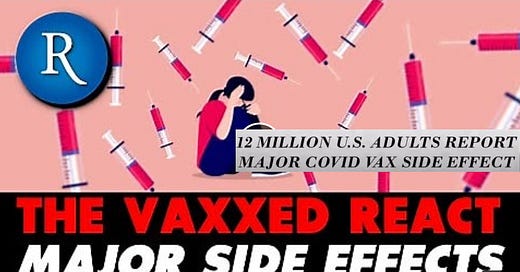



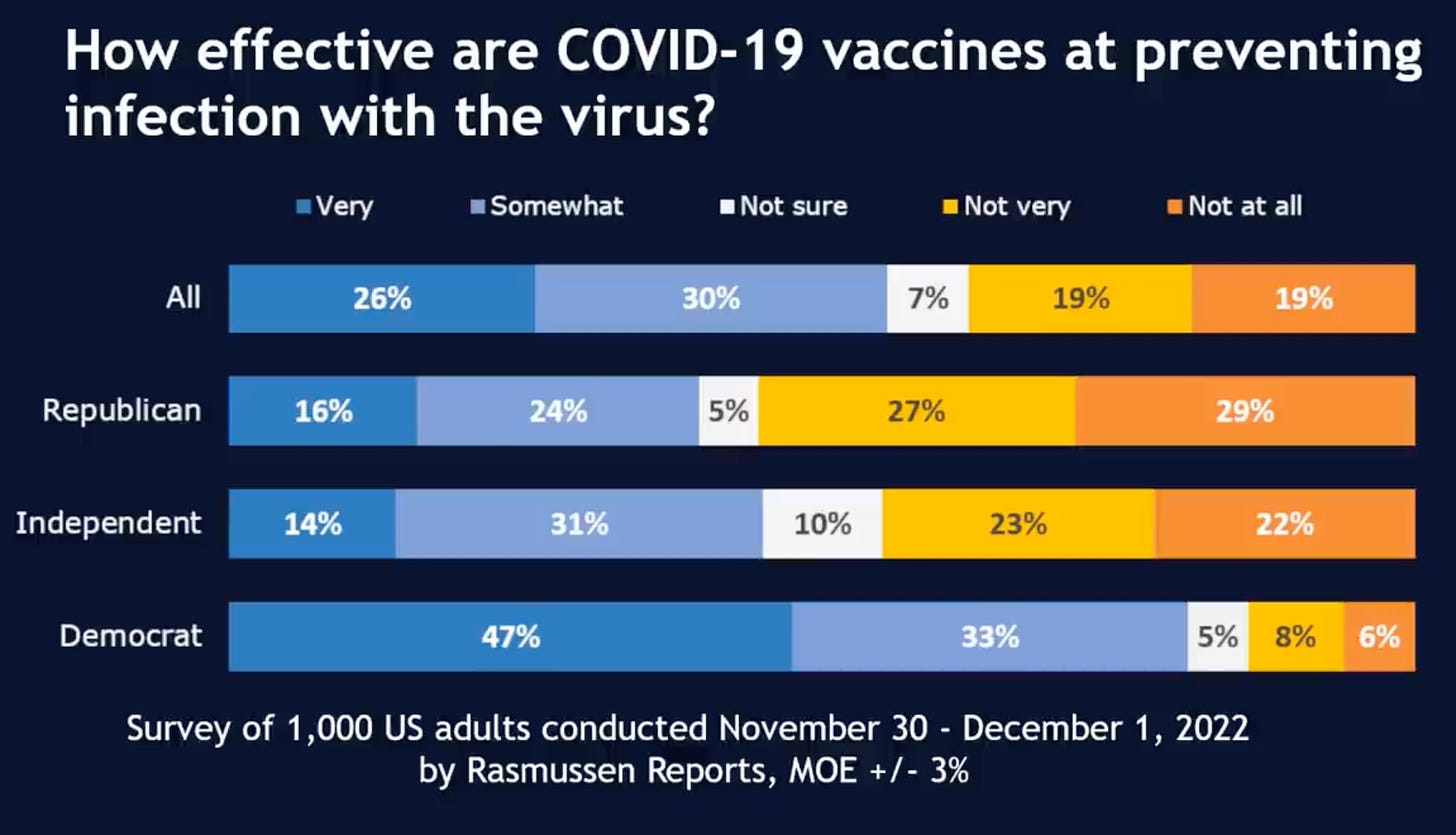
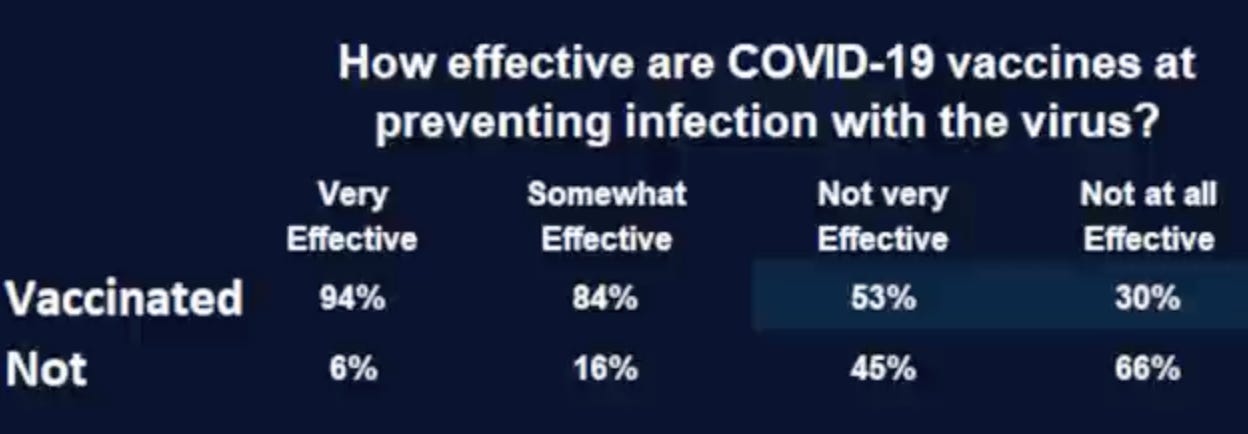

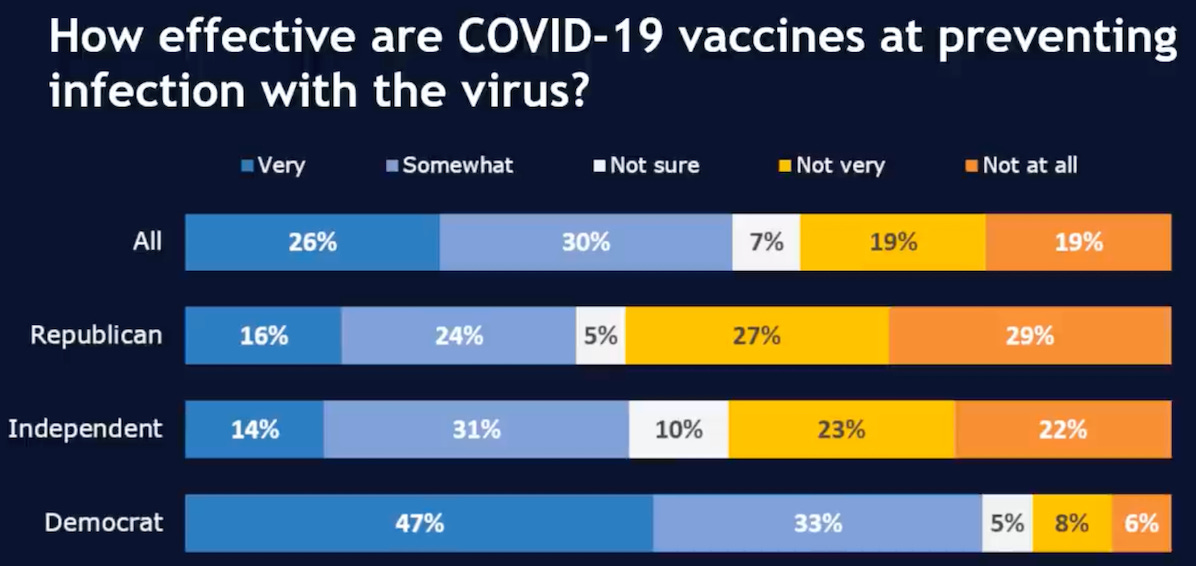



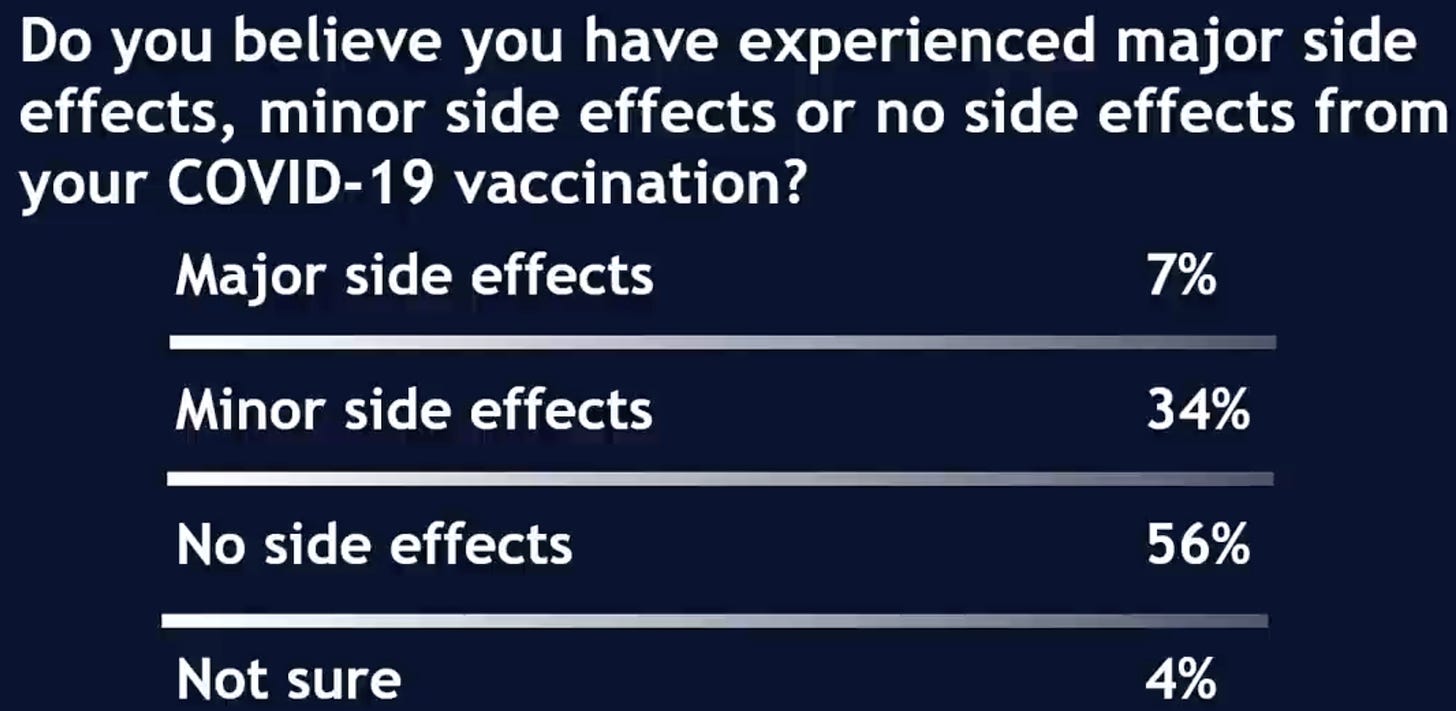
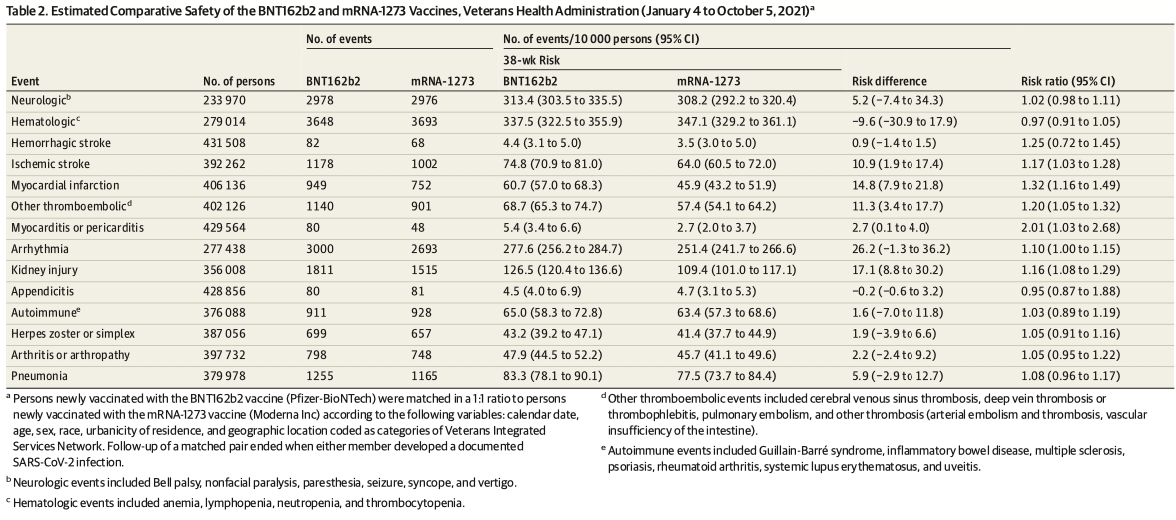
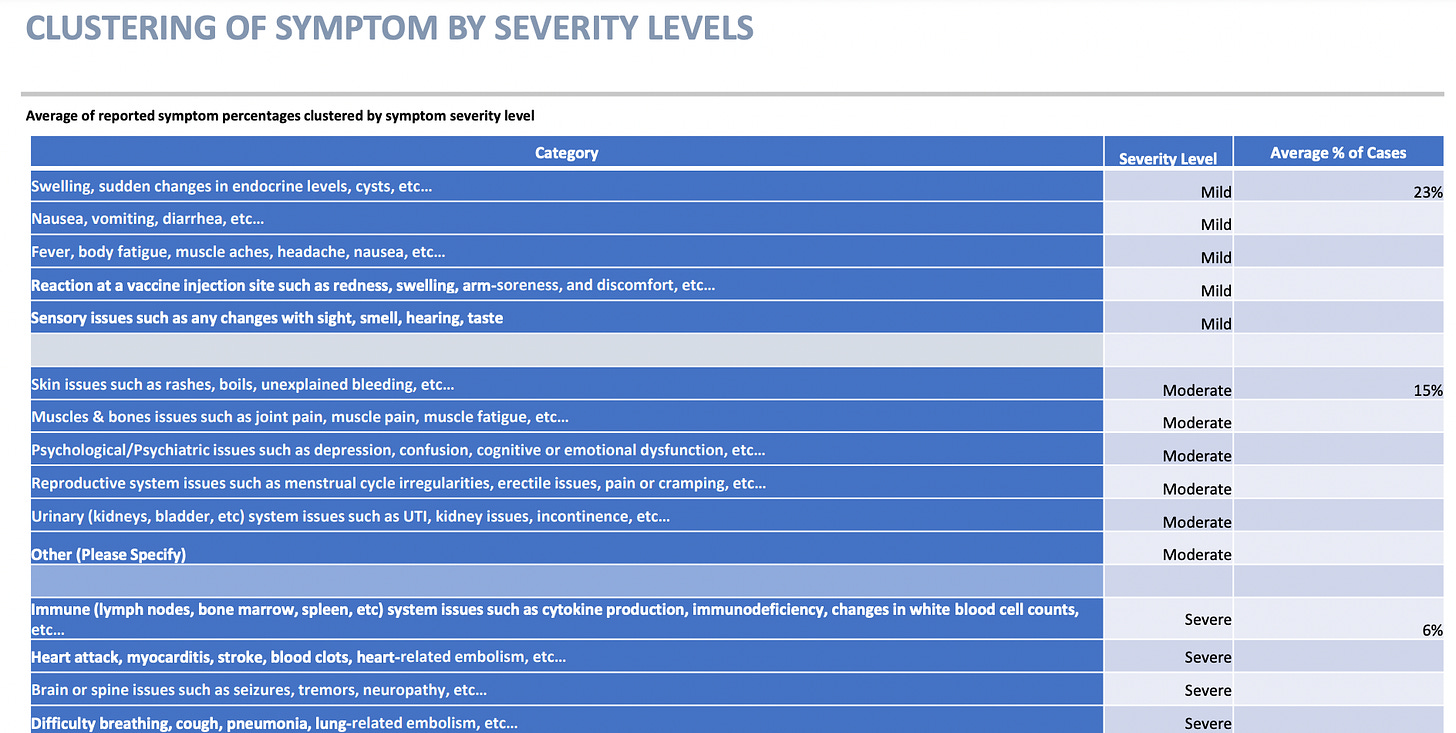


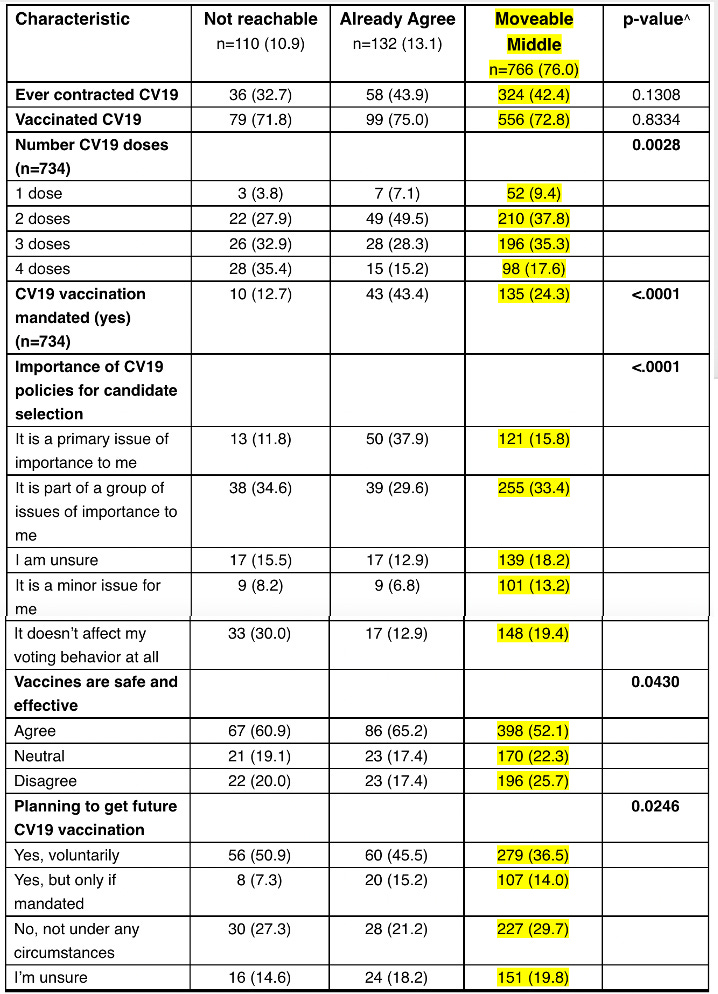
Thank you for this informative post. One thing I’ve done is place this information in my exam rooms on the walls and allow patients to decide for themselves without me coming across as a zealot trying to push what I think on them. Clearly, most are not aware of this and some even take pictures on their cellphones to pass the information to others. This has been very gratifying. And thank you for all the links.
Timely, as I am a concerned family doctor feeling myself slipping into some nihilism about society. Very black pilled at the moment. Thank you for your words.